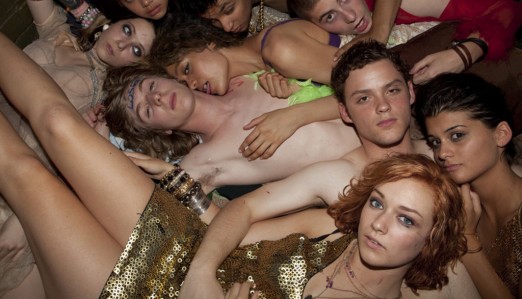 I hesitated to write about the new MTV series Skins, a remake of a BBC series by the same name. By pushing the envelope MTV knew that it would generate plenty of buzz–and contributing to that buzz, even in a very small way, makes me an accomplice in their marketing scheme. I’m going ahead with this post because I believe that the debate over Skins is one that must be joined if you’re going to engage modern popular culture and the role of media in shaping that culture. Recent accusations that the program may actually cross the line into child pornography is another reason why this is not just another Jersey Shore. Several of the actors on Skins are as young as 15 and that raises serious questions about the appropriateness of the acts they’re portraying on the small screen.
I hesitated to write about the new MTV series Skins, a remake of a BBC series by the same name. By pushing the envelope MTV knew that it would generate plenty of buzz–and contributing to that buzz, even in a very small way, makes me an accomplice in their marketing scheme. I’m going ahead with this post because I believe that the debate over Skins is one that must be joined if you’re going to engage modern popular culture and the role of media in shaping that culture. Recent accusations that the program may actually cross the line into child pornography is another reason why this is not just another Jersey Shore. Several of the actors on Skins are as young as 15 and that raises serious questions about the appropriateness of the acts they’re portraying on the small screen.
Skins premiered on MTV to strong ratings (3.26 million viewers 18-49) but fell to less than half this in its second episode. The premiere was likely boosted by two things: 1) people checking out the show to see what all the fuss was about and, 2) a new episode of Jersey Shore as a lead-in. Jersey Shore has been a ratings powerhouse and last week’s special episode (featuring the much publicized arrest of Snooki) drew 7.7 million viewers.
Despite the TV-MA ratings, Nielsen estimates that more than one-third of the Skins premiere audience were under the age of 18. That shouldn’t be surprising since MTV has claimed to own the teen demographic for some time.
Now, on to the controversy. David Carr, writing in the New York Times, makes an interesting point when he observed that Skins does not exist in a vacuum. While critics argue that these kinds of media portrayals are glamorized depictions far from reality, there’s also a bit of truth to MTV’s claim that much of the behavior we see in shows like Skins happens with or without media depictions. According to Carr,
Now that MTV is back on its heels, you will hear arguments that “Skins” merely describes the world that we already live in. There’s something to that. MTV didn’t invent “friends with benefits,” oral sex as the new kiss or stripper chic as a teenage fashion aspiration.
“Skins” is nothing new, only a corporate effort to clone a provocative drama that will make MTV less dependent on reality shows and add to the bottom line. True, MTV is not alone. Abercrombie & Fitch built a brand out of writhing, half-naked teenagers, as Calvin Klein once did.
But the critics of Skins also have justification to claim that media depictions of bad behavior are educational lessons, especially for young viewers. Once again Carr explains the difference between Jersey Shore and Skins in this regard.
Even in the most scripted reality programming, the waterfall of poor personal choices is interrupted by comeuppance. People get painful hangovers, the heartbreaks are real if overly dramatic and the cast members have to live with their decisions.
Not so on “Skins,” where a girl who overdoses and is rushed to the hospital wakes up to laughter when the stolen S.U.V. taking her there slams to a halt. Teenagers show children how to roll blunts, bottles of vodka are traded on merry go-rounds, and youngsters shrug off being molested and threatened by a drug dealer. And when the driver of the stolen S.U.V. gets distracted and half a dozen adolescents go rolling into a river, the car is lost but everyone bobs to the surface with a smile at the wonder of it all.
Leading the charge against Skins is Parents Television Council, a conservative media watchdog group, or, as their website puts it, “A non-partisan education organization advocating responsible entertainment.” PTC called Skins, “the most dangerous program ever” for children and their website includes an interactive feature that allows visitors to fire off a letter of disapproval to sponsors. And that tactic appears to be working.
MTV has seen important advertisers back away from Skins for fear of associating their brand with content that goes beyond edgy. Taco Bell (you know, the company using meat filling that is–surprise–significantly less than 100% beef), Gillette, Wrigley, Foot Locker, L’Oreal , Schick, and Subway have pulled spots. The movie studios and assorted products targeting the Skins demographic remained on the air in episode two. One of the spots on Monday night was for stretch mark cream. One commentator joked that it might have been a direct response ad! Oh, and you might not be surprised to learn that one of the advertisers of this week’s episode was the video game Dead Space 2 (see post below).
What do you think? Does the lifestyle presented by Skins and similar programs resonate with your personal experience? Are parents making too much of a fuss about something that will likely self-destruct on its own? Or is there something here that demands a response…something that, if left unchecked, will lead to even more dangerous behavior by even more adolescents?





